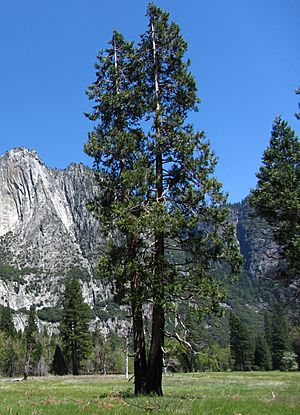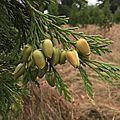Calocedrus decurrens facts for kids
Quick facts for kids Calocedrus decurrens |
|
|---|---|
 |
|
| Tree in Yosemite National Park, California | |
| Conservation status | |
| Scientific classification | |
| Genus: |
Calocedrus
|
| Species: |
decurrens
|
 |
|
| Distribution of Calocedrus decurrens in the Western United States | |
| Synonyms | |
|
|
The Calocedrus decurrens, often called the incense cedar, is a tall evergreen tree. It is a type of conifer, which means it has cones and needle-like or scale-like leaves. This tree is native to western North America. You might also hear it called the California incense-cedar. It is the most famous type of tree in its group, so people often just call it 'incense cedar'.
Contents
About the Incense Cedar Tree
The incense cedar is a very large tree. It usually grows to be about 40–60 m (130–195 ft) tall. Its trunk can be up to 1.2 m (3.9 ft) wide. The biggest known incense cedar is in Klamath National Forest in California. It stands 157.42 ft (47.98 m) tall!
This tree has a wide, cone-shaped top with branches that spread out. The bark is orange-brown when it's new. As the tree gets older, the bark turns grayish. It starts smooth but then gets cracks and peels off in long strips, especially near the bottom of the trunk.
Leaves and Cones
The leaves of the incense cedar grow in flat sprays. They are like small scales, about 2–15 mm (3⁄32–19⁄32 in) long. They are arranged in pairs, with each pair facing the opposite way. This makes them look like groups of four leaves. The leaves are bright green on both sides.
The seed cones are small, about 20–35 mm (3⁄4–1+3⁄8 in) long. They are pale green or yellow. Each cone has four (sometimes six) scales that are also arranged in opposite pairs. The outer scales each hold two seeds that have wings. The inner scales are usually empty and joined together. The cones change color to orange or yellow-brown when they are ready, about 8 months after the tree is pollinated. The pollen cones, which hold pollen, are about 6–8 mm (1⁄4–5⁄16 in) long.
Where Incense Cedars Grow
Most incense cedar trees grow in the United States. You can find them from central western Oregon, through most of California, and into the far western part of Nevada. They also grow a little bit into northern Baja California in Mexico.
These trees can grow in many different places. They are found at altitudes from 50–2,900 metres (160–9,510 ft) high.
How Incense Cedars Live
The incense cedar is a favorite home for a type of wood wasp called Syntexis libocedrii. This wasp lays its eggs in wood that is still smoking right after a forest fire. The tree is also home to a parasitic plant called incense-cedar mistletoe (Phoradendron libocedri). You can often see this mistletoe hanging from the cedar's branches.
Incense cedars are very good at surviving fires and dry weather in California. Even though a very hot fire can kill the tree, it grows back quickly after smaller fires. This helps the incense cedar do better than other trees, like the bigcone Douglas-fir, especially in recent years.
Uses of Incense Cedar
The wood from the incense cedar is mainly used to make wooden pencils. This is because the wood is soft and easy to sharpen without breaking into splinters.
Traditional Uses by Native Americans
The Native Americans of California have used the incense cedar for a long time. They used it in their traditional medicine. They also used it for basket making, to make hunting bows, and for building materials. They even used it to make fire by rubbing pieces of wood together.
The Maidu Concow tribe has a special name for this plant: hö'-tä in the Konkow language.
Growing Incense Cedars
Calocedrus decurrens is grown by plant nurseries as an ornamental tree. People plant it in their gardens and parks because it looks nice. It is used in many types of gardens, including those that save water (called xeriscapic gardens). It is also used in gardens that feature native plants and those designed for wildlife gardens. It is also used in projects that restore natural areas. People like it because of its tall, narrow shape and its green leaves all year round.
The tree is also grown in gardens and parks in places with cool summers. These areas include the Pacific Northwest in the Northwestern United States and British Columbia, and parts of eastern Great Britain and northern Europe. In these cooler places, the tree can grow an even narrower, column-like top. This is a bit of a mystery because it's rare in its natural warm home in California. Other trees in the Cupressaceae family can also have similar shapes. This plant has won an award called the Royal Horticultural Society's Award of Garden Merit, and so has a special type of it called 'Berrima Gold'.
Gallery
-
Incense cedar tree in McMinnville, Oregon
-
Incense cedar trunks in Lassen Volcanic National Park, California.
Images for kids
See also
 In Spanish: Libocedro de California para niños
In Spanish: Libocedro de California para niños









